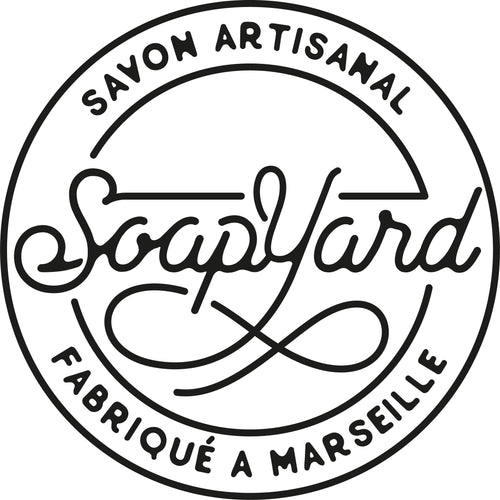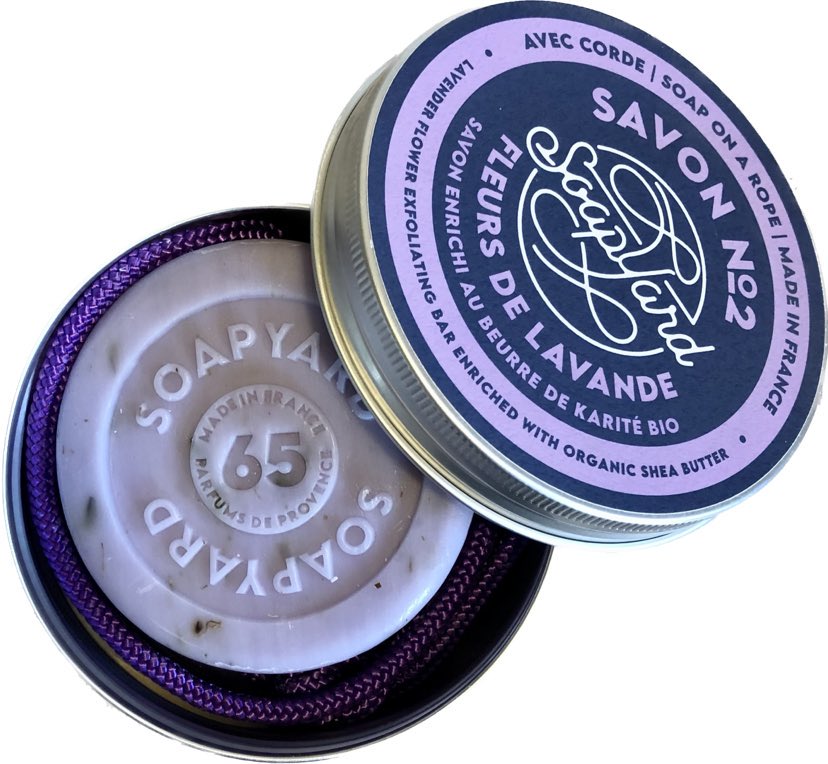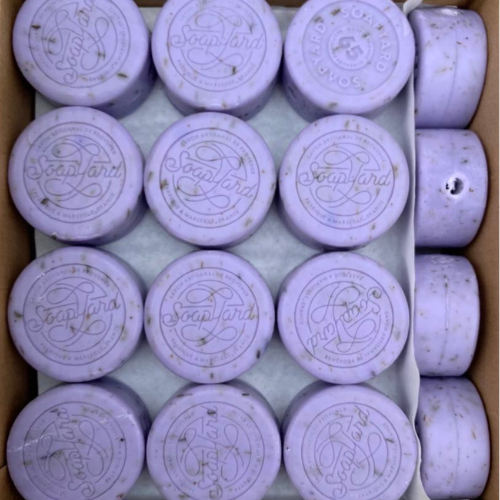
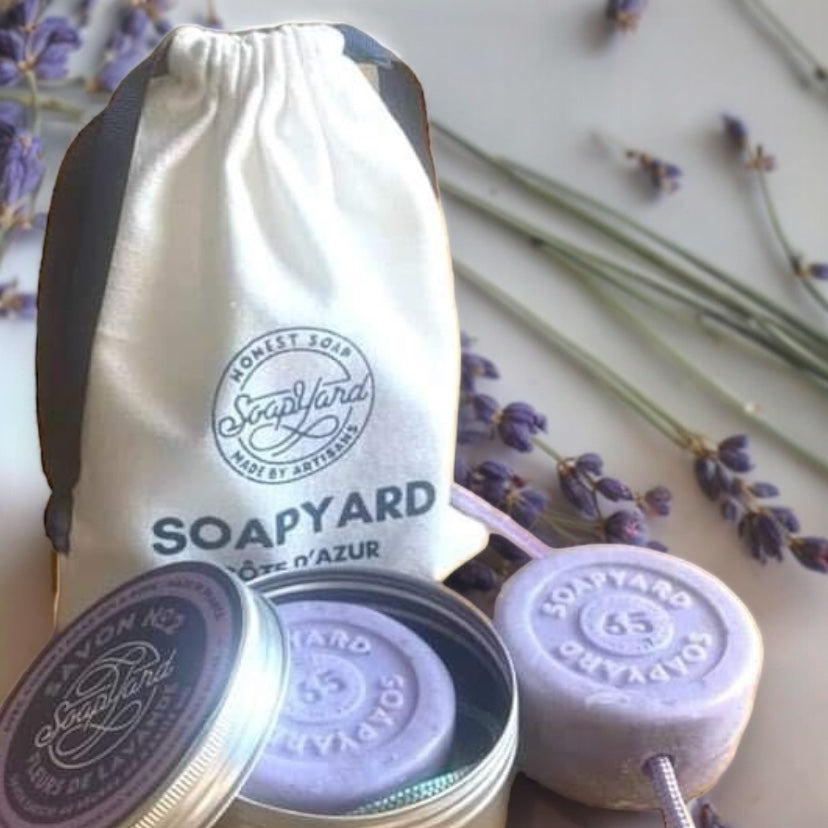
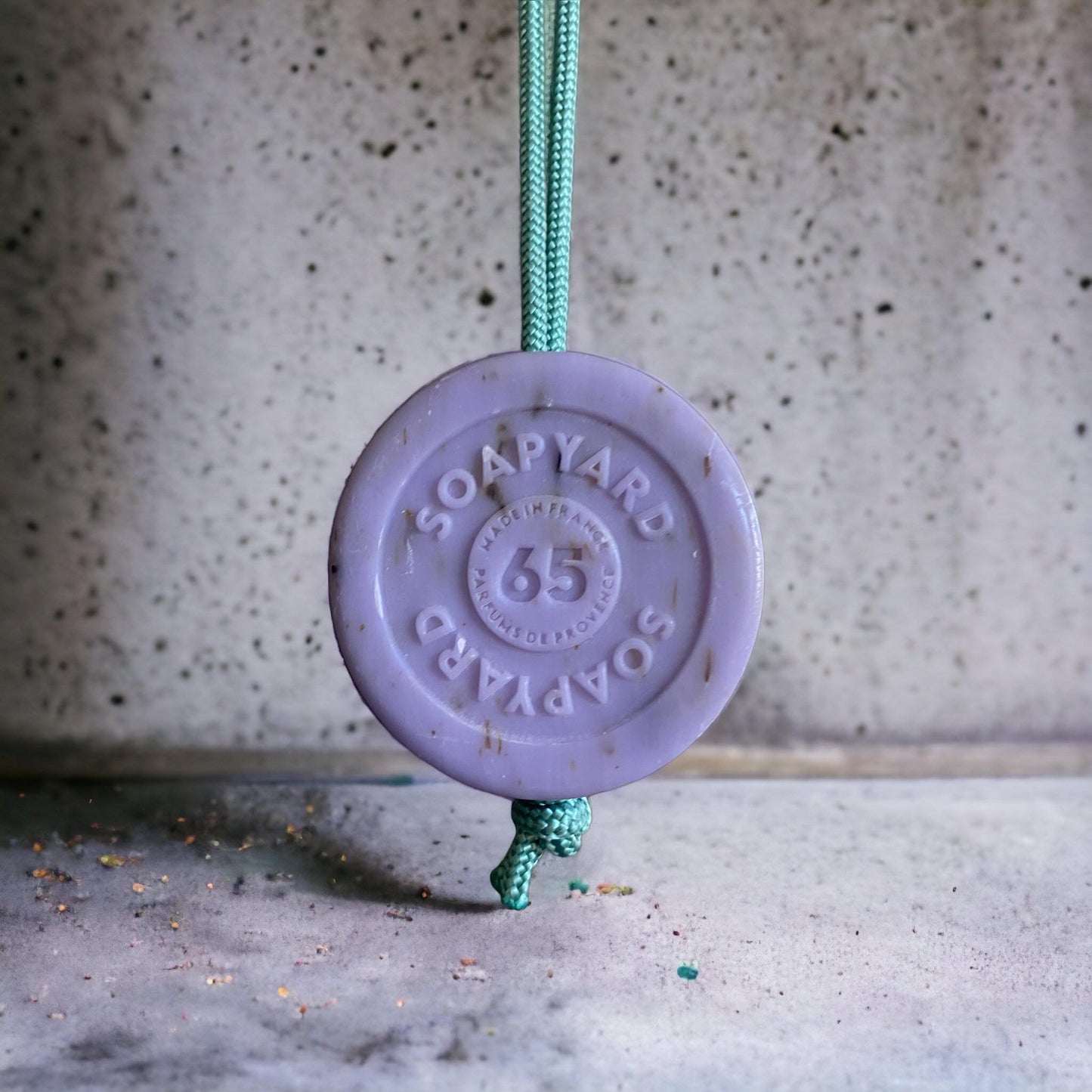

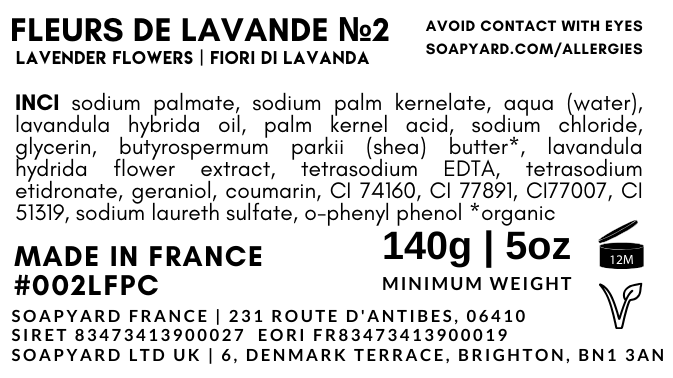
Little notes
SoapYard bars
Our bars are made by hand by artisans in the Marseille region of the South of France, using the traditional vegetable oil based recipes of the Provençal savonettes.
The soaps are also enriched with organic shea butter, which is a natural skin moisturiser and creates a natural creamy softening lather.
The soap is triple milled eliminating excess water and air, and this creates makes it a nice hard soap which feels luxurious to use. As it's a good hard soap, the soap should not go mushy and should last a long time.
Scent
The fragrances used in our bars are locally sourced from nearby Grasse in Provence, also known as the world capital of perfume.
Ingredients
*produit issu de l'agriculture biologique | organic | Bio
ARGAN N.20
INCI: sodium palmate, sodium palm kernelate, aqua (water), argania spinosa (argan) kernel oil*, parfum (fragrance), olea europaea (olive) fruit oil, laurus nobilis (bay) fruit oil, sodium hydroxide, palm kernel acid, sodium chloride, glycerin, butyrospermum parkii (shea) butter*, tetrasodium EDTA, tetrasodium etidronate, limonene, hexyl cinnamal, coumarin, citral, citronellol, geraniol, linalool, CI 11680, CI 77499, CI 77288
BERGAMOT N.46
INCI : sodium palmate, sodium palm kernelate, aqua (water), parfum (fragrance), palm kernel acid, sodium chloride, glycerin, butyrospermum parkii (shea) butter*, tetrasodium EDTA, tetrasodium etidronate, limonene, linalool, geraniol, CI 77492
CERISE | CHERRY N.38
INCI : sodium palmate, sodium palm kernelate, aqua (water), parfum (fragrance), palm kernel acid, sodium chloride, glycerin, butyrospermum parkii (shea) butter*, tetrasodium EDTA, tetrasodium etidronate, CI 12490
FLEUR DE CERISIER AVEC LAIT D'ANESSE| CHERRY BLOSSOM & ORGANIC DONKEY MILK N.25
INCI:sodium palmate, sodium palm kernelate, aqua (water), donkey milk*, parfum (fragrance), palm kernel acid, sodium chloride, glycerin, butyrospermum parkii (shea) butter*, tetrasodium EDTA, tetrasodium etidronate, CI 77891, CI 51319, CI 12490, sodium laureth sulfate, o-phenylphenol
CANNELLE | CINNAMON N.54
INCI : sodium palmate, sodium palm kernelate, aqua (water), parfum (fragrance), palm kernel acid, sodium chloride, glycerin, butyrospermum parkii (shea) butter*, tetrasodium EDTA, tetrasodium etidronate, cinnamaldehyde, linalool, eugenol, CI 77499, CI 77492, CI 77491
CANNELLE ORANGE | CINNAMON ORANGE N.55
INCI: sodium palmate, sodium palm kernelate, aqua (water), parfum (fragrance), palm kernel acid, sodium chloride, glycerin, butyrospermum parkii (shea) butter*, tetrasodium EDTA, tetrasodium etidronate, limonene, benzyl alcohol, CI 77492, CI 77491, CI 77499, CI 12085
NOIX DE COCO | COCONUT N.35
INCI : sodium palmate, sodium palm kernelate, aqua (water), parfum (fragrance), palm kernel acid, sodium chloride, glycerin,
butyrospermum parkii (shea) butter*, tetrasodium EDTA, tetrasodium etidronate, coumarin, benzyl salicylate, CI 77492, CI 77491, CI 77499
EUCALYPTUS N.11
INCI : sodium palmate, sodium palm kernelate, aqua (water), parfum (fragrance), palm kernel acid, sodium chloride, glycerin, butyrospermum parkii (shea) butter*, tetrasodium EDTA, tetrasodium etidronate, limonene, CI 77288
FIGIUER | FIG N.49
INCI : sodium palmate, sodium palm kernelate, aqua (water), parfum (fragrance), palm kernel acid, sodium chloride, glycerin, butyrospermum parkii (shea) butter*, tetrasodium EDTA, tetrasodium etidronate, benzyl benzoate, CI 77492, CI77491, CI 77499 CI 77288
GINSENG CURCUMA | GINSENG & TUMERIC N.66
INCI : sodium palmate, sodium palm kernelate, aqua (water), parfum (fragrance),helianthus annuus seed oil,olea europaea (olive) fruit oil,laurus nobilis (bay) fruit oil, curcuma longa root extract,panax ginseng root extract, palm kernel acid,sodium chloride, glycerin, butyrospermum parkii (shea) butter*,tetrasodium EDTA, tetrasodium etidronate,Illite (Argile jaune / Yellow clay)
PAMPLEMOUSSE | GRAPEFRUIT N.16
INCI : sodium palmate, sodium palm kernelate, aqua (water), parfum (fragrance), palm kernel acid, sodium chloride, glycerin, butyrospermum parkii (shea) butter*, tetrasodium EDTA, tetrasodium etidronate, limonene, linalool, benzyl salicylate, citral,
CI 11680, CI 12085
POMME VERTE | GREEN APPLE N.17
INCI :sodium palmate, sodium palm kernelate, aqua (water), parfum (fragrance), palm kernel acid, sodium chloride, glycerin,butyrospermum parkii (shea) butter*, tetrasodium EDTA, tetrasodium etidronate, amyl cinnamal, CI 77288
COEURS CORDÉ HEARTS WITH ROPES
ROUGE | RED
sodium palmate, sodium palm kernelate, aqua (water), parfum (fragrance), palm kernel acid, sodium chloride, glycerin,
butyrospermum parkii (shea) butter*, tetrasodium EDTA, tetrasodium etidronate, linalool, benzy salicylate, citronellol,
limonene, coumarin, CI 12490, CI 73360, CI 58000, CI 11680, CI 77891
BLANC | WHITE sodium palmate, sodium palm kernelate, aqua, parfum (fragrance), palm kernel acid, sodium chloride, glycerin, butyrospermum
parkii (shea) butter*, tetrasodium EDTA, tetrasodium etidronate, CI 77891
CHEVREFEUILLE | HONEYSUCKLE N.13
INCI : sodium palmate, sodium palm kernelate, aqua (water), parfum (fragrance), palm kernel acid, sodium chloride, glycerin, butyrospermum parkii (shea) butter*, tetrasodium EDTA, tetrasodium etidronate, limonene, hexyl cinnamal, linalool, coumarin, eugenol *Produit issue de l'agriculture biologique
JASMINE N.14
INCI : sodium palmate, sodium palm kernelate, aqua (water), parfum (fragrance), palm kernel acid, sodium chloride, glycerin, butyrospermum parkii (shea) butter*, tetrasodium EDTA, tetrasodium etidronate, amyl cinnamal, hexyl cinnamal, linalool, hydroxycitronellal, CI 11680, CI 12085 *organic/Bio
LAVENDE FLEURS EXFOLIANT | LAVENDER FLOWER EXFOLIANT N.2
INCI : sodium palmate, sodium palm kernelate, aqua (water), lavandula hybrida oil, palm kernel acid, sodium chloride, glycerin, butyrospermum parkii (shea) butter*, lavandula hydrida flower extract, tetrasodium EDTA, tetrasodium etidronate, geraniol,
coumarin, CI 74160, CI 77891, CI77007, CI 51319, sodium laureth sulfate, o-phenyl phenol
CITRON BROYÉ | LEMON EXFOLIANT N.5
INCI :sodium palmate, sodium palm kernelate, aqua (water), parfum (fragrance), palm kernel acid, triticum vulgare (wheat) bran, citrus aurantium dulcis, sodium chloride, glycerin, butyrospermum parkii (shea) butter*, tetrasodium EDTA, tetrasodium etidronate, limonene, citral, CI 11680, CI 12085
CITRON VERT | LIME N.36
INCI :sodium palmate, sodium palm kernelate, aqua (water), parfum (fragrance), palm kernel acid, sodium chloride, glycerin, butyrospermum parkii (shea) butter*, tetrasodium EDTA, tetrasodium etidronate, limonene, citral, geraniol, CI 11680, CI 74260
FLEUR DE LOTUS AVEC LAIT D'ANNESSE | LOTUS FLOWER & ORGANIC DONKEY MILK N.74
INCI: sodium palmate, sodium palm kernelate, aqua (water), donkey milk*, parfum fragrance), palm kernel acid, sodium chloride,
glycerin, butyrospermum parkii (shea) butter*, tetrasodium EDTA, tetrasodium etidronate, linalool, citronellol, hexyl cinnamal, limonene, alpha-isomethyl ionone, CI 77891, CI 74160
MANDARIN N.56
INCI : sodium palmate, sodium palm kernelate, aqua (water), parfum (fragrance), palm kernel acid, sodium chloride, glycerin, butyrospermum parkii (shea) butter*, tetrasodium EDTA, tetrasodium etidronate, limonene, CI 11680, CI 12085
MENTHE AVEC CHARBON ACTIF | MINT & ACTIVE CHARCOAL N.1
INCI :sodium palmate, sodium palm kernelate, aqua (water), argania spinosa (argan) kernel oil*, dipterocarpus turbinus balsam oil, charcoal powder, palm kernel acid, glycerin, sodium chloride, butyrospermum parkii (shea) butter*, tetrasodium etidronate, tetrasodium EDTA
MENTHE | FRESH MINT N.1
sodium palmate, sodium palm kernelate, aqua (water), parfum (fragrance), palm kernel acid, sodium chloride, glycerin,butyrospermum parkii (shea) butter*, tetrasodium EDTA, tetrasodium etidronate, CI 11680, CI 74260
MENTHE AVEC LAIT D'ANNESSE | MINT & ORGANIC DONKEY MILK N.1
INCI sodium palmate, sodium palm kernelate, aqua (water), parfum (fragrance), palm kernel acid, donkey milk, sodium chloride, glycerin, butyrospermum parkii (shea) butter*, tetrasodium EDTA, tetrasodium etidronate, CI 77288.
MENTHE EXFOLIANT | MINT & POPPY SEED N.1
INGREDIENTS sodium palmate, sodium palm kernelate, aqua (water), parfum (fragrance), palm kernel acid, sodium chloride, papaver somniferum seed extract, glycerin, butyrospermum parkii (shea) butter*, tetrasodium EDTA, tetrasodium etidronate, CI 11680, CI 74260
MENTHE ET HERBES DE PROVENCE | MINT & ROSEMARY N.1
INCI : sodium palmate, sodium palm kernelate, aqua (water), parfum (fragrance), palm kernel acid, sodium chloride, glycerin, butyrospermum parkii (shea) butter*, thymus vulgaris (thyme) extract, thymus serpillum (wild thyme) extract, origanum majorana herb extract, origanum vulgare (oregano) flower/leaf/stem extract, rosmarinus officinalis (rosemary) extract, ocimum basilicum (basil) flower/leaf/stem extract, artemisia dracunculus leaf/stem extract, salvia officinalis (sage) leaf extract, anthriscus cerefolium extract, tetrasodium EDTA, tetrasodium etidronate, CI 77288
FLEUR D'ORANGER | ORANGE BLOSSOM N.15
INCI sodium palmate, sodium palm kernelate, aqua (water), parfum (fragrance), palm kernel acid, sodium chloride, glycerin, butyrospermum parkii (shea) butter*, tetrasodium EDTA, tetrasodium etidronate, geraniol, linalool, citronellol, CI 12085, CI 11680
FRUIT DE LA PASSION | PASSION FRUIT N.58
INCI : sodium palmate, sodium palm kernelate, aqua (water), parfum (fragrance), palm kernel acid, sodium chloride, glycerin, butyrospermum parkii (shea) butter*, tetrasodium EDTA, tetrasodium etidronate, limonene, hexyl cinnamal, CI 12085, CI 12490
PATCHOULI N.23
INCI: sodium palmate, sodium palm kernelate, aqua (water), parfum (fragrance), palm kernel acid, sodium chloride, glycerin, butyrospermum parkii (shea) butter*, tetrasodium EDTA, tetrasodium etidronate, linalool, limonene, CI 51319, CI 12490, sodium laureth sulfate, o-phenylphenol
FRAMBOISE ET LAIT D'ANNESSE | RASPBERRY & ORGANIC DONKEY MILK N.78
INCI: sodium palmate, sodium palm kernelate, aqua (water), donkey milk*, parfum (fragrance), palm kernel acid, sodium chloride, glycerin, butyrospermum parkii (shea) butter*, tetrasodium EDTA, tetrasodium etidronate, benzyl benzoate, benzyl alcohol, coumarin, CI 77891, CI 12490, CI 58000, CI 77492
ROSE N.3
INCI : sodium palmate, sodium palm kernelate, aqua (water), parfum (fragrance), palm kernel acid, sodium chloride, glycerin, butyrospermum parkii (shea) butter*, vitis vinifera leaf extract, tetrasodium EDTA,ntetrasodium etidronate, geraniol, citronellol, benzyl benzoate, benzyl salicylate, linalool, CI 12085, CI 58000
ALGUES | SEAWEED N.30
INCI: sodium palmate, sodium palm kernelate, aqua (water), parfum (fragrance), palm kernel acid, bentonite, fucus vesiculosus powder, sodium chloride,
glycerin, butyrospermum parkii (shea) butter*, tetrasodium EDTA, tetrasodium etidronate, benzyl salicylate, linalool, geraniol
More about our bars
All Soapyard bar soaps are made by a small family run 'Savonnerie Artisanale' in the Marseille region of Provence in France.
The soap can be used as a soap-on-a-rope, with a wall magnet, or as a regular round bar soap in a soap dish. The hole through the middle - like all our bespoke bars enables you to use it with a handy interchangeable rope perfect for hanging and keeping the soap hygienic and dry between uses.
If you choose a colourful rope, the colour will vary and may not be the same colour as in the photo. The rope supplied is a hand-sealed length of paracord which can be switched to create lovely colourful soap & rope combinations. The rope can be re-used with a new bar or re-purposed.
The addition of organic shea butter reduces the drying effect associated with some other commercial bar soaps. Shea butter is a natural substance extracted from the fruits of the shea tree, known for its nourishing and protective properties. This soap is perfect for daily use.
No parabens or synthetic fragrances are used in this soap. The soap has a plant oil base and does not contain animal fats. There is no genetically modified component, and this soap is suitable for vegans*. As always, the bar soap is cruelty-free and not tested on animals.
The soap is triple-milled eliminating excess water and air, which makes it a nice, long-lasting hard soap which should not go mushy. As with any natural, artisan-made product, every bar might be a little bit different. Soap can behave differently depending on ambient humidity, heat and light. The soap is made with natural vegetable oils and naturally sourced local fragrances.
Like all our bars, this soap is detergent-free, paraben-free, and cruelty-free. The recipe is an age-old traditional formula, not tested on animals.
The soap is triple milled eliminating excess water and air, and this creates makes it a nice hard soap.
Looking after your bars
As with any natural, artisan-made product, every bar might be a little bit different. Soap can behave differently depending on ambient humidity, heat and light.
Try and keep your soap dry between uses and avoid letting it sit in water or on a wet surface.
If cracks appear in your soap, this is just moisture escaping and is part of the normal process. You can just rub it in, or under running water and smooth out the cracks. You can even melt and reshape the soap when it gets too small to use.
See online how to do this, and do not attempt without proper instructions.
Paracord
The rope we supply with our soap is raw edge, flame sealed, PPM paracord, more commonly known as parachute rope, sailing rope or nautical rope. PPM rope floats, dries quickly and rarely gets dirty which is why we think its perfect for our soap bars! It's also colourful, soft, it won't go mouldy or get dirty and it ties into a knot really well but also unties relatively easily if you want to change the length.
The PPM ropes we buy are made of Nylon and have a label (OEKO-TEX®) which indicates that the rope is non-toxic and safe for humans and animals. The rope we supply is Made in either the USA or the EU.
The paracord rope can be washed in the washing machine at max 30 degrees.
There are a lot of non-SOAPYARD related videos on YouTube explaining how to cut and seal paracord and what else you can use it for to make sure it lives another life when you want a new soap rope.
Disclaimer:
We supply raw-edge, flame sealed paracord and do not take responsibility for any changes you make to your rope. We cannot exchange the paracord. If you find that the cord frays a little at the end or if the rope is too long, you can re-cut it, and seal the ends with a flame, making sure to keep the flame at a distance and following all safety precautions which can be viewed on multiple sites on youtube but are not related to SOAPYARD.
We take no responsibilty for any actions taken with or using the paracord.
We consider paracord to be a zero-waste product because it can be repurposed and re-used over and over again. Bracelets, dog leads, washing lines .. all sorts!
